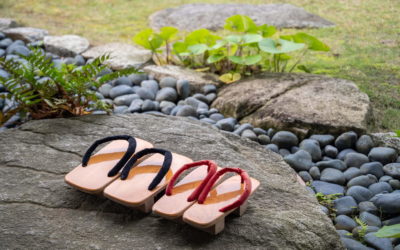In the final article in this three-part series exploring luxury hotels and a sense of place, Suzanne Godfrey, consultant, and lecturer in luxury and luxury hospitality, examines how hoteliers can overcome the challenges in providing local and authentic meaning of sense of place. The main challenge for luxury hotels is in creating and developing a sense of place in terms of location, and the overall guest and brand experience that reflects where you are, while staying true to who you are as a brand. It is the confluence between:
- the hotel brand – its origins, culture and identity; and
- the property’s location, which has its own history, heritage and culture.
It requires understanding the brand and its identity and having a clear vision, along with a set of brand guidelines that provides consistency across properties. But, it’s also about allowing enough flexibility to embrace a geographic sense of place through place identity. It’s the ability to reflect both brand and place identity in a relevant way, and to manage them consistently. Larger hotel groups appear to face greater challenges in achieving this. Constraints tend to arise from the organization itself and its culture, as well as the sheer size of the group with regard to the number of properties, the geographic spread and range of locations. This often results in a ‘cookie-cutter’ approach, with the individual hotel conveying the brand’s identity as one element of sense of place, but at the expense of place identity. Sense of place is best epitomized by individual and or privately-owned properties, such as Ritz Paris and Le Royal Monceau, Raffles Paris. It’s also seen in global luxury hotel groups, such as Rosewood Hotels & Resorts and One&Only Resorts who both claim ‘sense of place’ as core to their philosophy and ethos. They offer one-of-a-kind properties that truly embrace their location, whilst the brand and its identity are more subtly reflected. The brand is evidenced, for example, in the service style, use of rituals and a few specific brand-recognized signatures, the ambience and/or overall experience. In the case of Rosewood, there is little or no branding, such as a logo, evident within the hotel itself.
Case Study #1
Rosewood Hotels & Resorts trademarked the phrase “A Sense of Place”Ò when the group was founded in 1979. The tagline is used across their communications, and increasingly in their offerings, such as their “Sense of Place Journeys”, launched in 2014, which is “designed to immerse guests in the essence of some of the most desirable destinations in the world”. Jacques Oudinot, Hotel Manager of Hôtel de Crillon, Paris, during its renovation and reopening, defined it to me at the time: “The philosophy for Rosewood is of creating a sense of place. Rosewood is not a hotel group but a collection of hotels, which is very different. And that is our philosophy. So, every hotel respects the geography, the history, the DNA of the hotel. It does not impose architectural design, design standards, not at all, which is a delight to work with.”

Hôtel de Crillon, Paris — Copyright Suzanne Godfrey
In a recent CNBC interview, Rosewood CEO Sonia Cheng said: “Each property is designed to fit with its locality… It’s not a cookie-cutter approach. We really want to take the beauty of the city and weave it into the hotel.” And that’s exactly what they do. Each property is carefully curated with a “reflection of its location’s history, culture and geography”. They are conscious of maintaining this as they expand. Sense of place is also in evidence at other smaller luxury hotel groups which, to a greater or lesser extent, reflect their brand identity, but in a more obvious way than the previous examples. The Mandarin Oriental Hotel Group, which also claims to have ‘sense of place’ in its philosophy, is an example of this. It creates uniquely-designed properties that reflect both the Mandarin Oriental as a brand, as well as the specific location of the hotel. For example, every property includes a signature Mandarin Cake Shop and a spa that follows the Mandarin Oriental’s spa philosophy and approach to wellness. There are Asian touches in aspects of the design and décor, as well in employees’ uniforms. The fan logo is incorporated into various aspects of the design. There is also a locally-inspired and designed “fan”, which is unique to every property. The group has brand standards that are universal across the group, but individual hotels have the flexibility to adapt some of the service standards, for example, to reflect the local culture. Pierre Barthes, General Manager and Area Vice President of the Mandarin Oriental Hong Kong, describes ‘sense of place’ in the context of the group’s values: “While we believe that each hotel must reflect the best thing in the city or country in which it is located, we want to remind, in a subtle way, our guests of our oriental roots. Consequently, each hotel is encouraged to develop its own personality with a distinctive sense of place, while incorporating the Mandarin Oriental values, which essentially depend on our wonderful team of colleagues. For a new property, we weave this into all aspects of the project and through our core competencies: service, design, spa, dining, technology and marketing.” He goes on to explain what this means for a new property, “It’s about embracing the local culture in the design in keeping with the local surroundings. In other words, no standardization [across properties]. In Asia, it would mean incorporating the five natural elements and Feng Shui [energy] in our hotels. For the spa, it would be combining Asian philosophies with western techniques. For F&B it would mean creating innovative restaurants and bars reflecting the diversity of the local cultures using local-grown ingredients etc.” Take for example, Mandarin Oriental Jumeira, the group’s first property in Dubai, which opened last year. Richard Johnson, Hotel Manager, describes how they have integrated the brand into the hotel location to define its sense of place. “Our collection of art combines subtle touches of Arabic art mixed with Asian art. You’ll see it in the hallways, an Arabic piece next to a painting or print, next to it you’ll find an MO [Mandarin Oriental] inspired piece versus a locally inspired piece. We blended those things. Subtle, but we wanted the hotel to have its own personality”, which it most certainly does. He goes on to describe how they further implemented their Asian brand heritage into the guest experience: “We designed the uniforms to blend, yet be different with an Asian flair. You’ll see it in the housekeeping uniforms that colleagues are wearing in the public areas, as well as the front office ladies who have a Japanese-designed blouse, and throughout the hotel. In the evening, you’ll see the ladies in the lobby wearing these beautiful, Japanese-style dresses. There are little Asian touches here and there, but not too much.”

Asian influences at Mandarin Oriental Jumeira — Courtesy of Mandarin Oriental
Case Study #2
One&Only Resorts is a collection of resorts under Kerzner International, which includes two very different properties in Dubai, Royal Mirage and The Palm. Sense of place is in their DNA. “Mr. Sol Kerzner, founder of the company, always believed that our hotels will be landmarks that will define the city, the country, in which the hotels are opened. And we do that,” explains Sunil Iyer, Head of Quality & Training, Royal Mirage, Dubai. “Sense of place is one of our key factors. It’s in the DNA. Every Kerzner creation has to have a strong sense of place. For example, this particular property, any corner of this property you visit, you’ll find something really strongly inspired by Arabian hospitality, Arabian tradition. Look at the curtain design, look at the design of the lighting, the chandeliers. All our rooms, the interiors, are very Arabic inspired.”
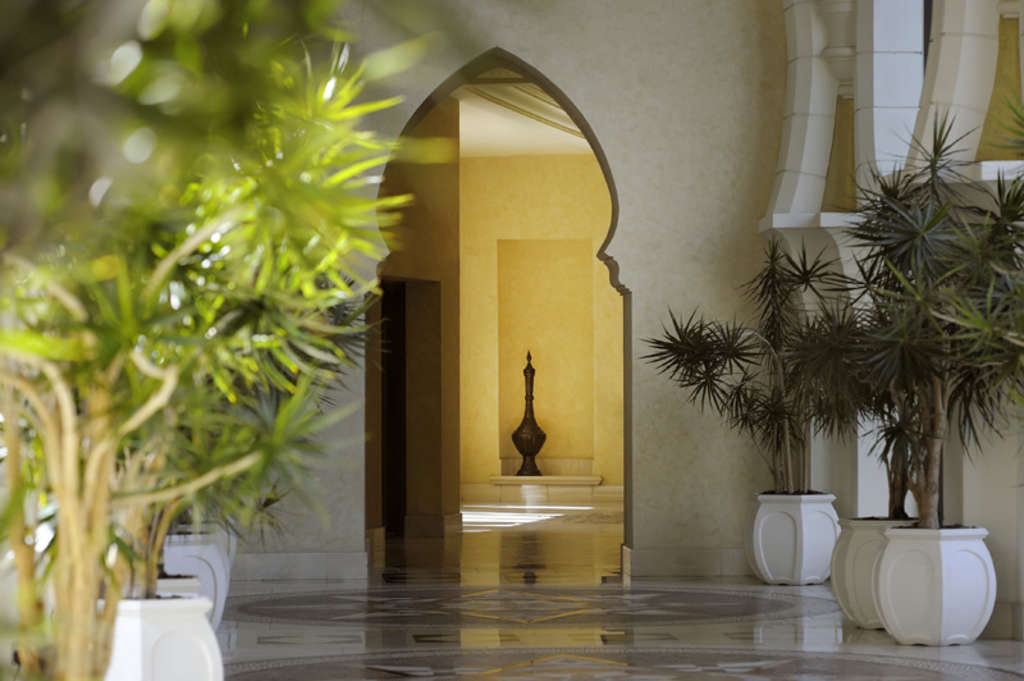
One&Only Arabian Court grand gallery — Courtesy of One&Only
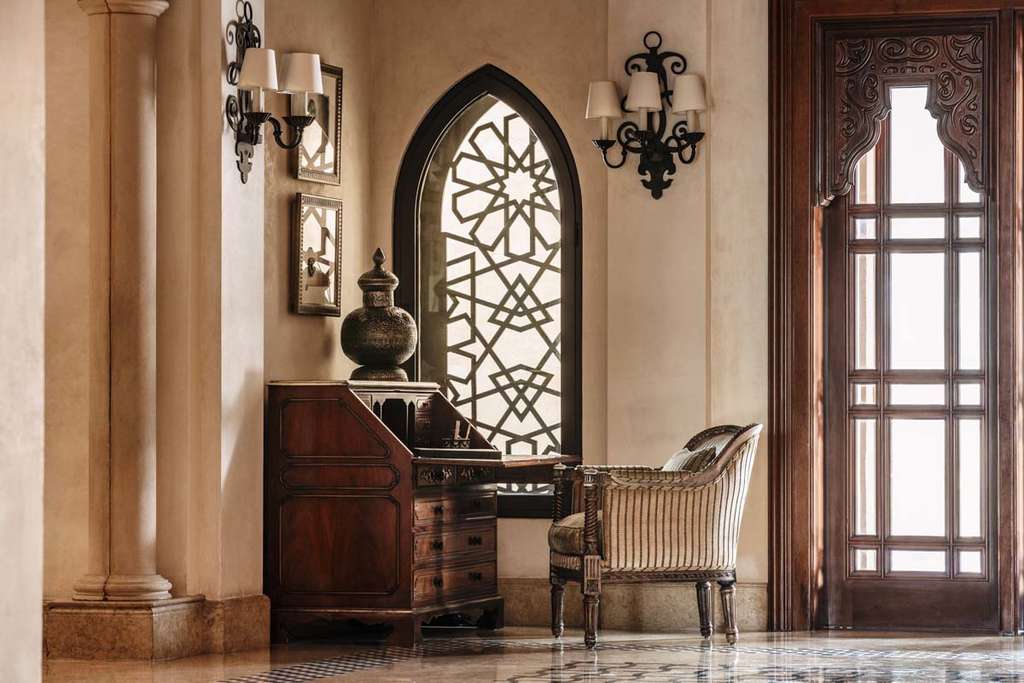
One&Only Royal Mirage, lobby desk of residences — Courtesy of One&Only
And the Royal Mirage was just that when it was first built 20 years ago. A picture taken at that time shows the property surrounded by desert. Back in those days, you’d walk outside and you’d see camels walking past. This was a ‘royal mirage’ and even today it remains true to its roots. At this property, Arabian hospitality remains valued today by visitors as well as locals. At One&Only The Palm, Dubai, sense of place is in evidence throughout the resort too – from what you touch, to what you feel and see. Located at the far end of the Palm with views across to Dubai’s skyline, it offers an idyllic escape from the bustling city; a beach resort that’s close to the city, while perched on the edge of the Arabian Gulf. The resort blends Middle Eastern influences with a contemporary palette of neutral tones and Arabesque design, giving it a chic and distinct identity. But, it’s more than just the design and architecture that conveys sense of place. One&Only The Palm also claim to bring guests “beauty and a unique cultural charm” that resonates with where and who they are, “along with style, personalized service and unique experiences”. One&Only is adept at translating sense of place with each of its hotels and resorts so they reflect their destination. Each is individual and unique. True to where they are. This is what One&Only is all about.
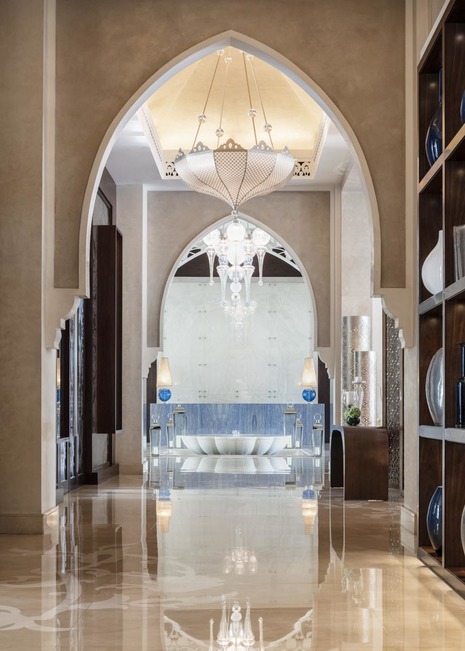
One&Only The Palm, lobby hallway — Courtesy of One&Only
A blend of brand and place identity is also in evidence in the Bvlgari – in particular the new Bvlgari Resort, Dubai, which opened at the end of 2017. It reflects both the brand’s jewelry heritage as well as its Italian – and particularly Roman – roots, but also pays respect to its location, situated on the shores of the Arabian Gulf with Arabic and Middle Eastern influence. Bvlgari’s reflection of its Italian heritage is in evidence throughout. Designed by Italian architect firm, Antonio Citterio Patricia Viel, which has to-date designed all the Bvlgari properties, the hotel is designed on the concept of a Mediterranean village. The brand’s Italian heritage can be seen in the architecture, use of materials such as Italian marble, and Italian design, as well as partnerships with luxury Italian furniture brands. It extends to their restaurant and cuisine and the creation of an Italian garden of lemon trees: La Limonaia. The brand’s jewelry heritage is reflected in vintage photos of celebrities and ‘La Dolce Vita’ – the pleasures and indulgent life of Italy in the ’60s – which adorn the walls of the lobby and public areas (the company has recently been buying back pictures at auction to meet their expansion plans). There are also original sketches of some of Bvlgari’s jewelry from the brand’s archives. There is Il Cioccolato, the chocolate boutique, which offers a selection of handmade “chocolate gems”, some featuring the Bvlgari logo, presented like jewels in small jewelry-inspired gift boxes. And, when you arrive at the property, you’re welcomed by Bvlgari’s eight-pointed star motif, which is inlaid in the floor.
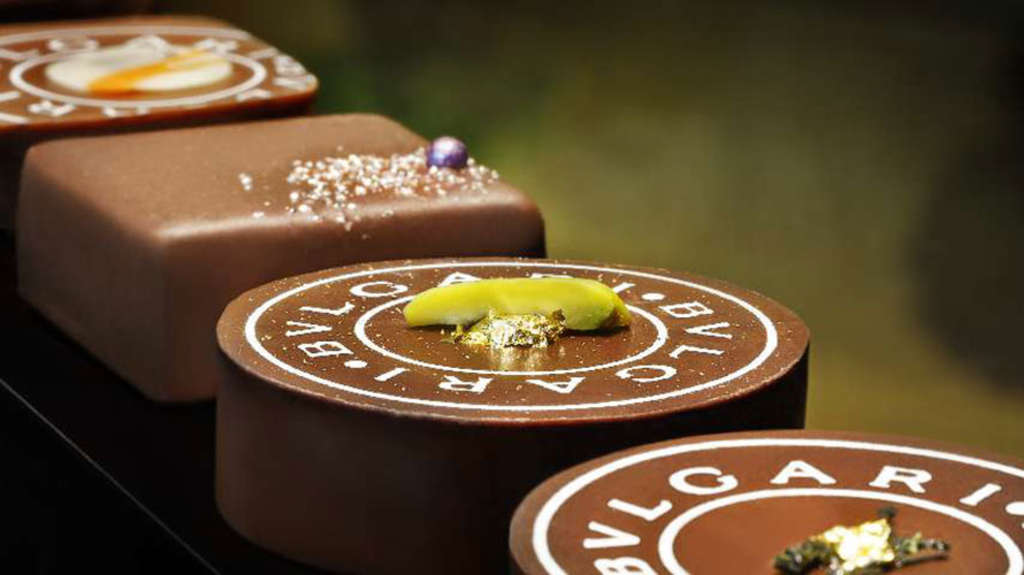
Chocolate gems, Il Cioccolati, Bvlgari Resort Dubai — Courtesy Bvlgari Hotels & Resorts
The addition of the Yacht Club, a first for Bvlgari, pays homage to the concept of a Mediterranean village, as well as the city’s maritime heritage of traders, fishermen and pearl divers. The club includes an Italian seafood restaurant, vintage photos of celebrities aboard luxury yachts and further images reflecting La Dolca Vita. The chinaware has also been specifically designed for the club and uniquely bears the Bvlgari name and logo. This represents a real step-up in their branding and integration of the brand name into their hotels and resorts.
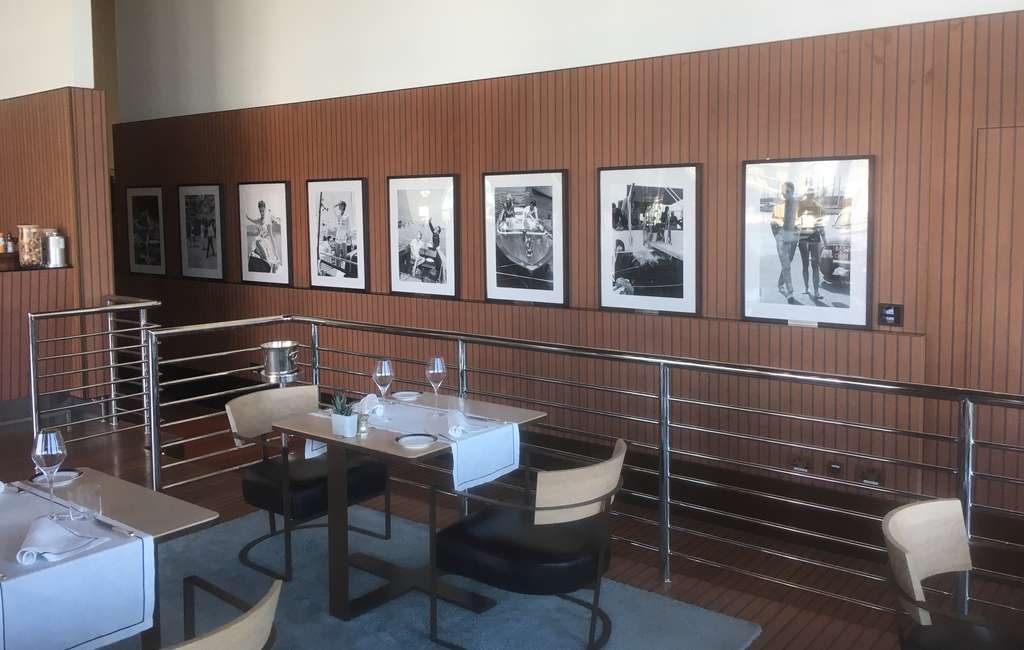
Bvlgari Yacht Club Dubai — Copyright Suzanne Godfrey
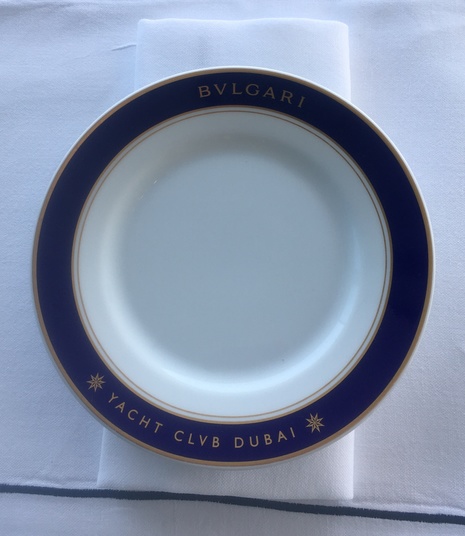
Branded chinaware at Bvlgari Yacht Club Dubai — Copyright Suzanne Godfrey
The Bvlgari Resort Dubai also pays respects to its location with evidence of traditional Arabic design and materials. From locally-inspired lanterns outside each room to the white coral-designed ‘brise soleil’ to provide shade from the sun. The muted Bvlgari color palate lends itself well with the use of sandstone to reflect the desert. There are also subtle touches such as the inclusion of local Arabic and Middle Eastern flavors and ingredients like dates and pistachios in the chocolates, complementing the use of Italian ingredients such as Italian Gorgonzola cheese, balsamic vinegar and mascarpone.
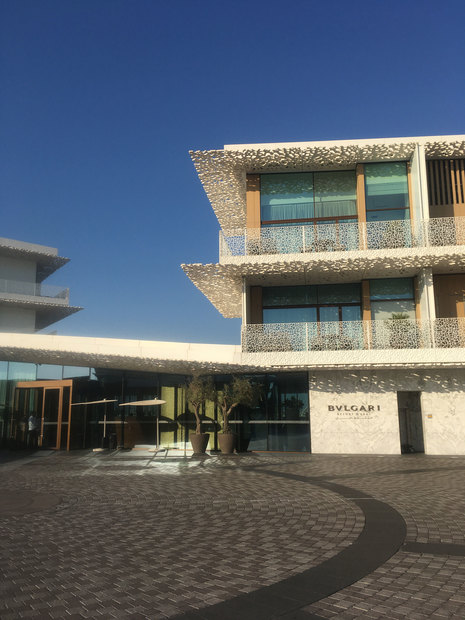
Bvlgari Resort Dubai, exterior with brise soleil — Copyright Suzanne Godfrey
In summary, each property within these smaller luxury hotel groups may have an individual identity that reflects its location, history and heritage, and contributes to its soul, but also reflects the ‘parent’ brand through architectural and design features, icons and signatures including color palette, service standards and specific rituals, and, to a greater or lesser extent, their logo. So, what role does ‘sense of place’ play in hospitality and luxury hotels in particular? In short, sense of place can offer:
- Place identity that defines where you are with respect to the local history, heritage, culture and environment;
- Brand recognition and, with it, familiarity, comfort and security;
- Differentiation versus competition with the specific integration of brand identity and place identity that is unique;
- Historic or iconic buildings can contribute to the ‘soul’ of the individual hotel and further enhance its history and heritage, as well as place identity;
- Finally, it provides an opportunity for meaningful cultural and curated experiences.
The ultimate challenge – but also the opportunity – is in crafting that “deeper and more textured” story that reflects sense of place for the brand and within each individual property, which resonates with meaning for guests and keeps them loyal to the brand, wherever they are in the world.
[The author would like to thank Stuart Pallister for his editorial comments and suggestions].
References: Personal conversations and interviews with hoteliers in Paris in 2017, Dubai and Hong Kong in 2019.


